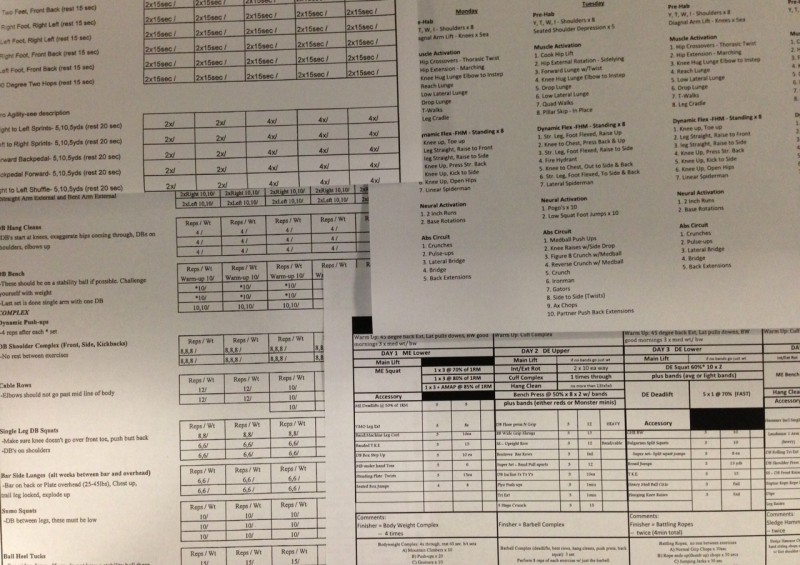The Problems with College Softball Summer Strength and Conditioning Programs
If you are a high school senior who has committed to play in college next year, there is a good chance you have already received your “summer workout program” from your college coach. These programs used to come in the mail, spiral-bound with laminated covers, although you may have printed out the 50-plus pages from your email. Traditionally, these books are filled with a philosophical introduction from your coach or strength coach, essential fitness tests that you will need to be prepared for, a training calendar, workout sheets, and exercise descriptions.
In accordance to your program, you will be required to complete prescribed speed/agility, strength, and conditioning workouts each week. Many days will include multiple workouts, since speed, strength, and conditioning normally require separate facilities and equipment (i.e. track, turf, gym).
These programs are comprehensive; however, the more complex the programs are, the less practical they become and the less likely athletes are to follow them. Below I briefly discuss more issues with these programs.
- Too many exercises – As I write this, I am looking at a summer college workout program which, on one day, has 31 exercises for a warm up.
- Too difficult – Universally, fitness programs have mutated to “how-can-I-almost-kill-you” workouts, or similarly, programs that are designed to challenge “mental toughness”.
- Too complicated – Related to difficulty, programs with too many exercises or too many instructions are too overwhelming. Coaches in general need to be aware of the TL;DR phenomenon. It says something about today’s athletes.
- Insufficient instruction – If words, pictures, or illustrations could teach an athlete to power clean, I would be out of a job. Even the most thorough video tutorial or exercise demonstration can backfire because of something I will coin TL;DW. Too long. Didn’t watch. Athletes need basic exercises with simple, task focused cues or reminders to help the perform the exercises correctly, and they need it in fewer than 10 words or 30 seconds.
A reminder, I am speaking specifically about programs given to incoming freshmen. I assume upperclassmen would be able to replicate the programs they have followed throughout the school year into and throughout the summer. Unfortunately, many coaches do not delineate between returning and incoming athlete summer programs. Substantiating the construction of the summer program is less important than understanding the reality of today’s high school athlete. Although there are exceptions, these are considerations coaches should appreciate when designing collegiate preparatory programs:
- No gym experience – Plain and simple. How many high school female athletes can squat, deadlift, lunge, do 20 push ups and 10 pull ups? How many athletes have ever been taught proper running posture and mechanics? Can they march, skip, jump, hop and bound? Why are the programs more complicated than this?
- No fitness – Straight up. Sport specialization and fitness level are inversely related. Playing the same sport all year round does not cause you to be unfit. It causes you to spend less time performing other activities, at other speeds, with different levels of stress and coordination. It prevents you from committing time to a fitness program at least, and prohibits you from resting your body, mind, and spirit at worst.
- No supervision – Injuries caused by exercise or weight training, for any athlete of any age or gender, are directly related to one thing: supervision. I think we would all agree we would take an “unfit” athlete over an injured athlete come September. I think programs should assume that the athletes will be unsupervised and unspotted, therefore the directions need to be very, very clear.
- No “facility” – There are gyms everywhere and I wish, as much as anything, young athletes would get to them more often. I do not care if it is Planet Fitness where the dumbbells only go up to 50 pounds and you can’t drop the weights or dare grunt if you are doing squats (if you can even do squats there). However, many collegiate summer programs include exercises that require specialized equipment that you would find in a college weight room, but not your hometown family-friendly gym. And we do not want to encourage athletes to invent exercises or come up with “suitable” alternatives.
For athletes who can relate to the points I have made, do not worry. Next week I will introduce our College Softball Summer Training Program. This project will be designed to be the most practical college-preparatory training program that you will be able to complete at most commercial gyms. It will include proper warm ups, speed training, strength and conditioning workouts. Not only should you look forward to a program that you can actually complete, you should be confident that it will fulfill all of your college coach’s expectations once you arrive in the fall.